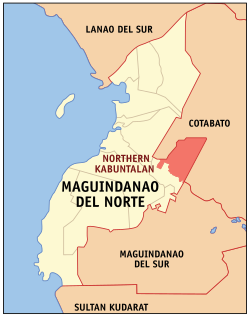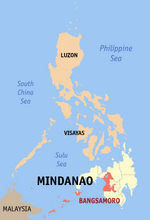Northern Kabuntalan
Northern Kabuntalan | |
|---|---|
 | |
| Country | Philippines |
| Founded | December 30, 2006 |
| Barangays | (see Barangays) |
| Government | |
| • Mayor | Datu Umbra B. Dilangalen |
| • Vice Mayor | Datu Mohammad Shaffie C. Bayam |
| • Representative | Sittie Shahara "Dimple" I. Mastura |
| • Municipal Council | Members |
| • Electorate | voters (?) |
| Highest elevation | 38 m (125 ft) |
| Lowest elevation | 0 m (0 ft) |
| Economy | |
| • Poverty incidence | % (?) |
| Service provider | |
| • Electricity | — |
| Time zone | UTC+8 (PST) |
| PSGC | PSGC unknown |
Northern Kabuntalan, officially the Municipality of Northern Kabuntalan (Maguindanaon: Ingud nu Northern Kabuntalan; Iranun: Inged a Northern Kabuntalan; Tagalog: Bayan ng Northern Kabuntalan), is a 5th class municipality in the province of Maguindanao del Norte, Philippines. According to the 2020 census, it has a population of 26,277 people. [3]
During the second regular session of the first legislative assembly of the Autonomous Region in Muslim Mindanao, the regional legislature created Northern Kabuntalan out of 11 barangays of Kabuntalan, by virtue of Muslim Mindanao Autonomy Act No. 206,[4] which was subsequently ratified in a plebiscite held on December 30, 2006. The town was part of the province of Shariff Kabunsuan until its nullification by the Supreme Court in July 2008.
The ARMM law creating the municipality provides that its administrative center shall be established in barangay Tumaguinting.
Geography
Barangays
Northern Kabuntalan is politically subdivided into 11 barangays.
- Balong
- Damatog (Poblacion)
- Gayonga
- Guiawa
- Indatuan
- Kapimpilan
- Libungan
- Montay
- Paulino Labio
- Sabaken
- Tumaguinting
Climate
| Climate data for Northern Kabuntalan, Maguindanao | |||||||||||||
|---|---|---|---|---|---|---|---|---|---|---|---|---|---|
| Month | Jan | Feb | Mar | Apr | May | Jun | Jul | Aug | Sep | Oct | Nov | Dec | Year |
| Average high °C (°F) | 32 (90) |
32 (90) |
33 (91) |
33 (91) |
31 (88) |
30 (86) |
30 (86) |
30 (86) |
31 (88) |
31 (88) |
31 (88) |
31 (88) |
31 (88) |
| Average low °C (°F) | 22 (72) |
22 (72) |
22 (72) |
23 (73) |
24 (75) |
24 (75) |
23 (73) |
23 (73) |
23 (73) |
23 (73) |
23 (73) |
22 (72) |
23 (73) |
| Average precipitation mm (inches) | 38 (1.5) |
24 (0.9) |
29 (1.1) |
31 (1.2) |
50 (2.0) |
56 (2.2) |
52 (2.0) |
49 (1.9) |
39 (1.5) |
47 (1.9) |
54 (2.1) |
35 (1.4) |
504 (19.7) |
| Average rainy days | 10.1 | 7.5 | 10.0 | 11.5 | 19.7 | 20.8 | 19.4 | 18.5 | 16.3 | 18.5 | 18.4 | 12.8 | 183.5 |
| Source: Meteoblue (modeled/calculated data, not measured locally)[5] | |||||||||||||
Demographics
| Year | Pop. | ±% p.a. |
|---|---|---|
| Source: Philippine Statistics Authority [6] [7] [8] | ||
Economy
References
- ^
- ^ "2015 Census of Population, Report No. 3 – Population, Land Area, and Population Density" (PDF). Philippine Statistics Authority. Quezon City, Philippines. August 2016. ISSN 0117-1453. Archived (PDF) from the original on May 25, 2021. Retrieved July 16, 2021.
- ^ a b Census of Population (2020). Table B - Population and Annual Growth Rates by Province, City, and Municipality - By Region. PSA. Retrieved 8 July 2021.
- ^ "Muslim Mindanao Autonomy Act No. 206; An Act Creating the Municipality of Northern Kabuntalan in the Province of Maguindanao, Providing Funds Therefor, and for Other Purposes" (PDF). Regional Legislative Assembly, Autonomous Region in Muslim Mindanao. Retrieved 27 January 2016.
- ^ "Northern Kabuntalan, Maguindanao : Average Temperatures and Rainfall". Meteoblue. Retrieved 19 January 2019.
- ^ Census of Population (2015). Highlights of the Philippine Population 2015 Census of Population. PSA. Retrieved 20 June 2016.
- ^ Census of Population and Housing (2010). Population and Annual Growth Rates for The Philippines and Its Regions, Provinces, and Highly Urbanized Cities (PDF). NSO. Retrieved 29 June 2016.
- ^ Censuses of Population (1903–2007). Table 1. Population Enumerated in Various Censuses by Region: 1903 to 2007. NSO.
External links
- Northern Kabuntalan Profile at the DTI Cities and Municipalities Competitive Index
- MMA Act No. 205 : An Act Creating the Municipality of Northern Kabuntalan in the Province of Maguindanao
- Newly created provinces, municipalities, barangays, converted city Accessed on March 9, 2006.
- String Module Error: String subset index out of range000®code=String Module Error: String subset index out of range&provcode=String Module Error: String subset index out of range Philippine Standard Geographic Code
- Philippine Census Information
- Local Governance Performance Management System
- Pages using the Graph extension
- Articles with short description
- Pages using PH wikidata incorrectly
- Philippine articles requiring maintenance
- Pages using infobox settlement with no coordinates
- Articles containing Tagalog-language text
- Errors reported by Module String
- AC with 0 elements
- Municipalities of Maguindanao del Norte
- Populated places on the Rio Grande de Mindanao
- Populated places in Maguindanao del Norte
